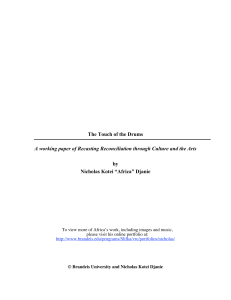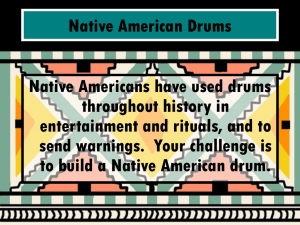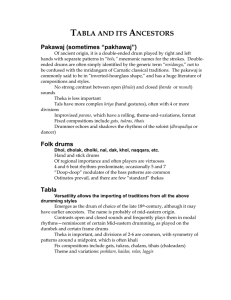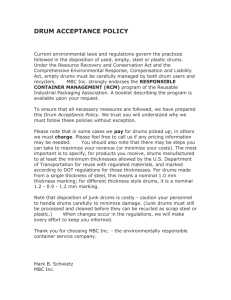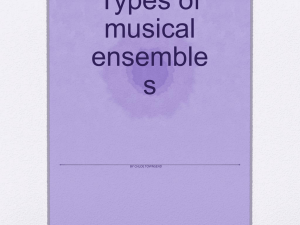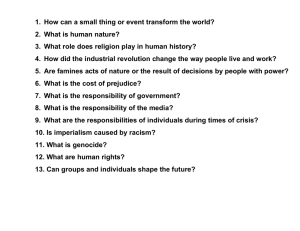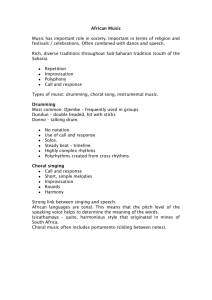The Touch of the Drums: My Story By Nicholas “Africa” Kotei Djanie
advertisement
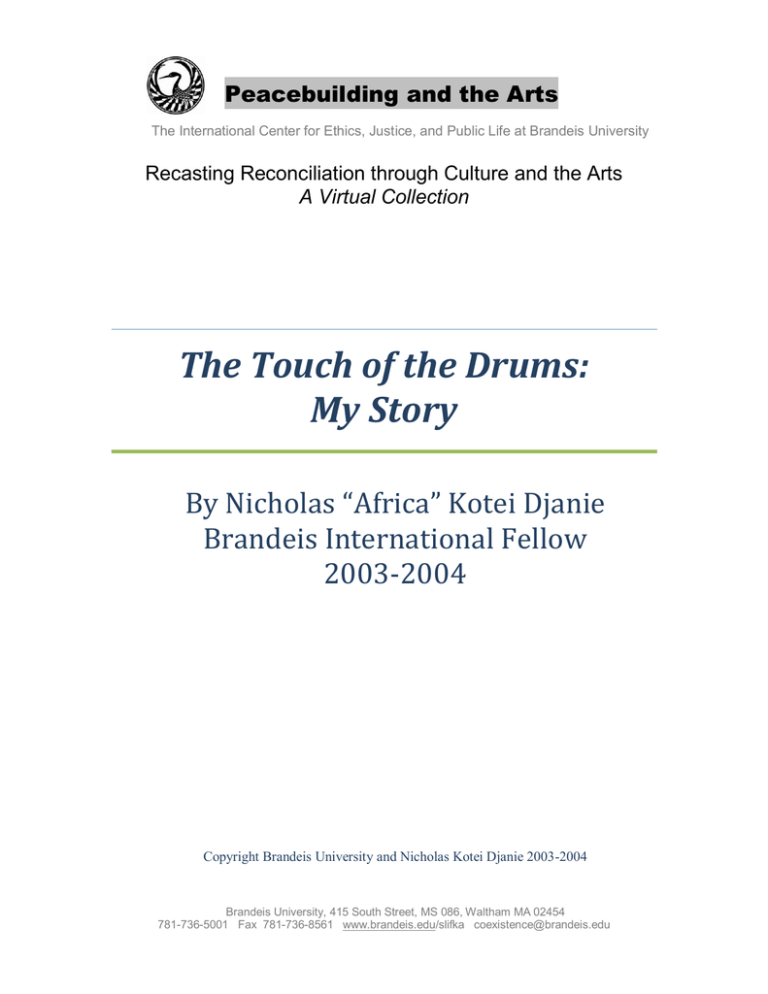
Peacebuilding and the Arts The International Center for Ethics, Justice, and Public Life at Brandeis University Recasting Reconciliation through Culture and the Arts A Virtual Collection The Touch of the Drums: My Story By Nicholas “Africa” Kotei Djanie Brandeis International Fellow 2003-2004 Copyright Brandeis University and Nicholas Kotei Djanie 2003-2004 Brandeis University, 415 South Street, MS 086, Waltham MA 02454 781-736-5001 Fax 781-736-8561 www.brandeis.edu/slifka coexistence@brandeis.edu Burundi I was born into a family whose parents did not become who they wanted to be or what their parents had wanted them to be. The tree of poverty was planted in their house. Life was not easy for my family. We found it hard to cope with the children of the fruitful ones, the children whose parents could take care of their needs. How does one manage to survive in such a family and community? The cry from inside of me was met with natural talent. My talents pulled me in the direction of the sounds of the drums, singing and dancing, even though this created a conflict between me and my parents. They wanted me to further my education, even though they couldn’t afford it. But they still wanted me to achieve a high degree. Gradually, they came to respect me; I became their eyes, capable of seeing farther into the world. I began to realize what drums can do in a community, among friends, among a group of people who feel troubled or disturbed and who have forgiveness on their minds. What do I mean by this? The drumming stops you from thinking about the past and the future, and brings you into the present. And the present is where things happen, where people start to think about things at that moment, and to make decisions. It is the first thing that brings people together, and that is what is needed before anything else can happen. I love my talent because it is both my job and my fun. I always say, may the spirits of my ancestors be with me, those who ruled without war and who fought without weapons (except knowledge). May God also be with me. I have been to many countries, rich and poor; however, to me it makes no difference, because what I want is to be with people whose situation I understand. Working with Trouble-Minded People I like to work with people whose minds are troubled and who have to cope with a life that is not easy. When people are disturbed, the first time they see the drums, they can become nervous. They start to think about what they are about to do and whether they will be able to do it, with all that is on their minds. They wonder if they will be able to sit down and drum with the person who caused all of the problems in their lives. When the people I work with express this feeling, sometimes I will ask them to start by putting their heads down and expressing their feelings – not with their mouths, but on the drums that are in front of them. Some play soft, some play loud and rough, others do not play at all. After they get the rhythm, I tell them to look at each other’s hands and find a place where they hit the drums at the same time. That is the moment when any one of them can join in. [Nicholas suggests we put a video clip in here; he will try to email one to me.] With this exercise, by looking at the hands of the others or the way that they The Touch of the Drums 1 Burundi play, they can help themselves come together and return to their own rhythms. I also tell them to listen to the two different parts that they are each playing separately, and to hear how beautiful the cross-rhythms sound. Sometimes those who were playing softly will start to cry and some of them will go and comfort each other. To me, they are now becoming one and they are ready to receive any information I offer them, and to stand together to help themselves. I am amazed by the way the drum works. The spirits of the wood from the forest and the from the skin of the animals (also from the forest) are with the drum wherever it goes or however it is used. That is why it connects the people to their ancestors, preparing warriors for war and creating fun for people as well. Different People, Different Places I have been with many people from different places, who have different feelings. What I have seen is that drumming, dancing and singing together is one thing they can all understand and do together, in spite of their differences. It touches them when they become their own entertainers and when they get soaked in fun. It is not a matter of speaking English, French or Chinese, or of having a certain degree, or coming from a certain place. Everyone can make music together. Drumming and dancing have been used in communities for many centuries to bring people together, have fun, communicate, bury their differences, create a common ground for people to tell their stories, and connect them to their ancestors. Some of the political leaders in my country started using drumming and dancing to bring people together in the towns, villages and cities. They would do this before they would deliver their message because it is very difficult for them to get enough people to attend their gatherings. However, during the drumming and dancing, people gather around to watch and then they start to participate. Singing and dancing together creates a sense of belonging to the community, a desire to participate in everything that goes on in the community, and a desire to listen to anybody who wants to help the community. Then the politicians take it from that point, to tell the people what they want to accomplish for the community. Challenges in South Africa We did a three-day drumming workshops on the townships of South Africa. It went really well; many people participated and contributed. Most of the old people in the community were encouraging the young ones to participate. This is how the community should be, not with people stealing from or shooting each other, but with people using what belongs to them to create their own contributions. Sometimes I get frustrated and discouraged and think that I am at the end of the help I can give with the resources that I have. In South Africa, I faced challenges from some of the older men that nearly discouraged me. One of the old men asked the people I was The Touch of the Drums 2 Burundi working with why they were allowing a foreigner to lead them in a drumming circle. He asked, “Doesn’t this bring us back to the way things were before?” But then another man interrupted. “He is not here to lead them to fight or do bad things, but to have fun and share what he has with them. Isn’t that OK?” I once did a gig for blind people. These are the people who cannot see what happens to them, although they can hear and feel it. Among these were two girls who said they had been raped, but they were obviously unable to identify their rapists, because they could not see them. But as for the sound of the drums, they could hear. One of the girls stood up and started to describe the drum by asking me about it. Are these drums carved out of one piece of wood? I said yes. And animal skin on top? I said yes. What animal skin? I said goat. She said, “I wish I could describe everything that I’ve touched and mention their names, especially human beings.” She was crying because she was one of the victims. After positioning them where their drums were waiting, I started to show them a few techniques and teaching them the basic rhythm. Then I taught them a song that goes with the rhythm they had learned to play. These are the lyrics of the song: Naki leee… Naki leee (Naki, where are you?) Yebi Naki lee mobawosio (My daughter Naki, come back home.) Then everyone repeats the same words after I finish the call: Naki leee… Naki leee Yebi Naki mobawosio. The song is about a mother who is calling her daughter who has gone to play at the riverside and is late coming home. So the mother went walking through the forest shouting these words because she does not know what has happened to her daughter. Some people did not want to sing because they said that they couldn’t sing and play at the same time. I told them that although it was difficult, they should stay with their difficulties in order to learn new things. Learning new things would make them happy, I said, and if I can do it, so can you. All you have to do is know your problems and think about what can bring a solution. In this case, know the rhythm and, at the same time, learn how to sing with it. They tried and tried, and they did not give up until most of them could sing while playing a different rhythm on the drum. Burundi I’ve been to Burundi and Rwanda. Most artists from my country do not like to go there because there has been a war going on, and they are afraid that they won’t come back home. However, those are the places where I was working hard while having the The Touch of the Drums 3 Burundi most fun. In these places, sign language [link to image on slide #21 on Powerpoint] is more important than your own spoken languages. The spirit of being an artist was very strong because you need to act your words [link to image on slide #7 of Powerpoint]so people will understand you, and they sometimes use sign language among themselves, too. I tried to work with differences among the people by asking one of the less educated, rural people lead the group in an exercise with some of the music we were going to learn. [link to image #10 of the Powerpoint] These are the places you sometimes smile with sadness, and laugh with tears on our eyes. Happiness is mixed with sorrow. I choreographed the whole piece from happiness to sadness and back to happiness again. Everything went well until we reached the genocide section. There, things started to slow down. Some did not want to take any role because their families had been killed; others had family members who had been killers. I asked them if they could not bear their feelings in order to work on the piece, how would they be able to take it out and educate people, show people how the problems had been solved or how they could be solved in the future. “It is your responsibility as citizens of Rwanda to help your country heal wounds and put on a new cloth to show the world how beautiful a country it is.” I had been invited to Rwanda by an artist, a woman who was coordinating the whole project. She had worked on part of a composition before I arrived. It showed how people were massacred and how some of the priests had participated in the genocide. They had called the Tutsis to come and hide in the churches, and then they called the Hutus to come and kill them. Some of the priests were killers themselves. Before I arrived, the people had been working on their own to develop ways to portray some of the characters involved in the genocide. I was very pleased with their work, because I could start with their characters and add my ideas. Some people were crying while they were playing those characters. In addition, some outsiders came to watch the rehearsals, and they were crying to. At that point I realized that the piece was working, and I was confident that when we would perform it, the audience would feel it and understand it. When the story was completed, we took it to the theatre so the public could come and watch. During and after the show, people were crying, both Hutus and Tutsis. After the show, they invited people to suggest how roles might change or what sections might be added. Members of the audience volunteered to show how people with wounds were hiding with their children; others wanted to show how people could now live together happily, and so on. My fourth time in Rwanda was the most significant of all: the tenth commemoration of the genocide. This performance would be seen not only by Rwandans, but by the whole world. Some volunteers and I were working with 600 children (including the president’s daughter and the prime minister’s children), 80 dancers, a 60-person choir, and a 40-piece army band. It was a huge challenge to work with such a large number of people, ranging in age from 8 to 70 years, both Hutus and Tutsis. Most of the people The Touch of the Drums 4 Burundi knew much more about the genocide that I did, and they had an overwhelming number of suggestions about what we should include. One woman, for instance, argued that we needed to start from the beginning and portray everything about the genocide, included who caused it and how it began. I asked somebody to explain to her that if we had to show every single thing, the performance would take us many days. “But we need something to explain the entire genocide,” she argued. “What does he know about the genocide?” she asked, referring to me. I began to wonder about how outsiders can be accepted to help resolve a conflict. During the rehearsals, many people were crying and being traumatized because of the gestures and songs they were using, and because most of the lines were testimonies from genocide survivors. The choir sang songs that had been composed by people who had had visions of the genocide and started composing songs to try to make people aware of what was about to happen. Some of these composers themselves later were then actually killed in the genocide. Other songs were composed after the killing. Most of the people could not hold back their tears. I sometimes walked out and burst into tears myself. Eyes and noses were running. The floor on which we were working became slippery with people’s tears. Both sides were drowning in sorrow. They are still in the process of healing their wounds. Reflections I have seen the benefit of the path that I took. I came from a place of struggling, to a place of solving not only my own problems but helping others as well. I believe that most of what we have inside us can become tools to help others to develop themselves and see the brightness of their futures. Talent is natural. It works in a natural way in human beings. When we look inside ourselves, we see natural things which can be used to help others. I want to work with people who don’t believe that what they have is useful, so they too can develop their talents and help others. I want to develop a community which will help these kinds of people, because the more we have people involved in helping, the fewer people will be there to destroy. As I write this, I am now performing in a Broadway show. I feel I came from nowhere to somewhere. If I hadn’t had people to encourage me, to help me develop my talents, I might have ended up on the opposite way. Humanity and community work together. When humanity leaves the community – when a community loses trust, respect and friendship – then conflict arises. So we should focus on protecting the community so violence won’t arise, rather than just reacting after people are already suffering. I love human beings. And humanity is what makes human beings human. We The Touch of the Drums 5 Reflections shouldn’t forget about our own humanity. We should develop our talent of respecting humanity and respecting every culture. As the world becomes smaller, we need to share our cultures with each other. By doing that, we can come together. The thing I love most in the world is the people, because I am one of them. I want always to be with the people, and contribute to them by showing my humanity. The Touch of the Drums 6
